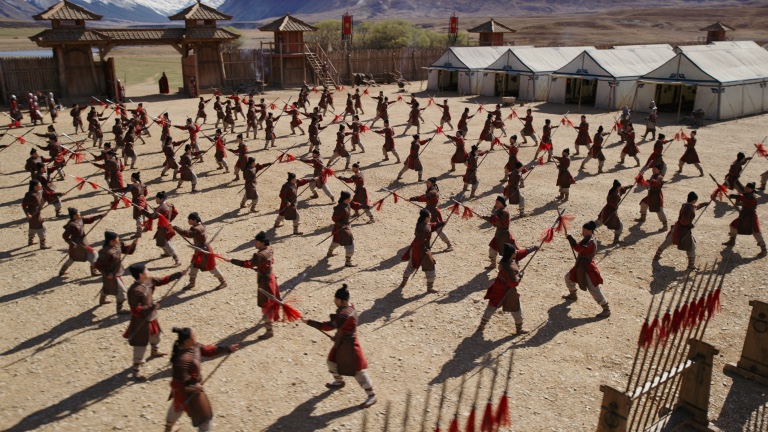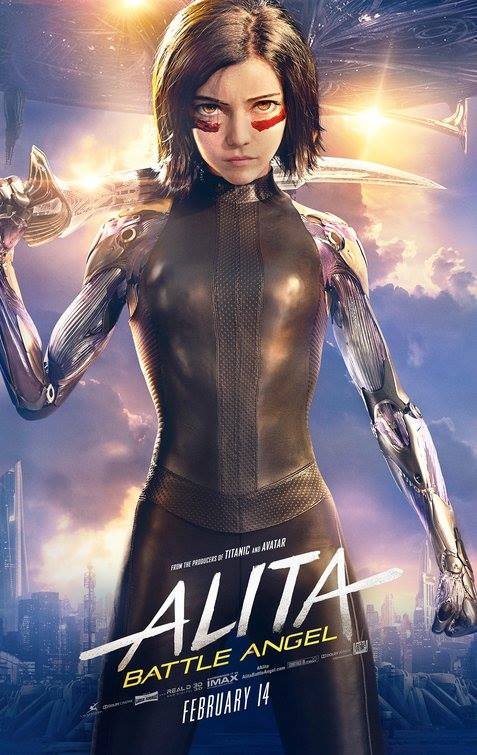
To create a photorealistic computer-generated character who must carry an entire film as its titular star, the filmmakers behind Alita: Battle Angel relied upon the performance capture footage shot by director Robert Rodriguez of leading actress Rosa Salazar on stage in Austin, Texas. “Rosa is the basis for Alita all the way through,” said Eric Saindon, visual effects supervisor on the project. “Everything about her became Alita. The design is all Kishiro—it’s where everything started.”
Added visual effects supervisor Richard Hollander from LA-based Lighstorm Entertainment, “A lot of hard work from Rosa Salazar because she set up the character in the movie. Then, a lot of really hard work from the team from Weta.”
Indeed, Weta Digital in New Zealand had the primary responsibility of acquiring Salazar’s captured performance footage and translating the data into a fully computer-generated character. Similar techniques were utilized for Avatar, but in the ten ensuing years, the technology had become significantly more advanced. “We took scans of Roses’ eyes and mouth in high resolution and used those in Alita,” Saindon said of work at Weta Digital. “The detail we can get in the body capture is much higher fidelity. We are doing two cameras for facial capture. We are able to gather a lot more information than we could on Avatar.”
During principal photography, Salazar performed day-to-day on set as she might have on any standard live-action set, interacting with other performers just as she would if she was performing on a movie without digital visual effects. “It was about rules in the beginning,” Saindon explained. “Robert asked, ‘What can I do? What can I not do?’ The thing that was most amazing was the flexibility of what Robert could do; we wanted Robert to direct Rosa to touch and interact with the environment with no restrictions. It made our job a hell of a lot harder later, but it also connected the actor and the CG character together.”
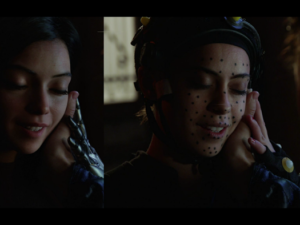
Additionally, Richard Barneham, visual effects creative supervisor for Lightstorm Entertainment, noted hurdles that needed scaling in endeavoring to bring a computer-generated character to life. “You want to credibility and continuity of a performance to be intact,” he described. “We allowed the performance to be organic. Once you get to the post side, it’s much easier to recreate an interactive performance of a CG character than live-action elements.”
As opposed to a character created digitally with the benefit of performance and facial capture of an actor, a digital character can also be created from scratch with keyframe animation. “It’s interesting because with a digital hero character for an entire film, you have choices,” noted Mike Cozens, Alita’s overall animation supervisor. “We could have keyframed her, and when you keyframe, you’re working with dozens of artists to come up with a performance. From scratch, no reference footage, artists are making a whole bunch of choices.”
Keyframing can also be based on indirect reference material, as with a sequence of Gollum from The Lord of the Rings trilogy. In that case, Weta Digital used Andy Serkis’ live action performance as a cornerstone to lend credibility and continuity to the performance of digital Gollum. “That allows a singular point of reference; a sympathetic performance by the actor as opposed to an empathic performance,” said Berneham. “If you do that, base your performance on a singular acting choice—which is Rosa all the time—it means you have continuity of character, a vocabulary of facial performance you can stick to, even down to the idiosyncrasies of the character, matching the physiology of the actor’s face.”
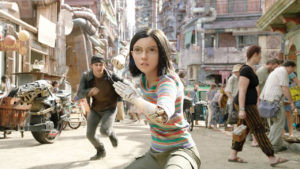
Naturally, Alita’s character needs to evolve throughout the film. She starts as an innocent, passionately responding to the world she has stumbled into, and, then, over the course of the story, she becomes a warrior and a woman, all actuated by Salazar’s performance. “You’re working with dozens of artists in post-production,” said Cozens. “It’s really easy to step on and mess with a performance that is inspired by single moments in time by an actor. So, the goal for the team was to keep the spark and that energy alive, so the evolution of that character is visible for the audience, and the audience is carried into the character. You need all things wrapped up together to make a performance feel true.”
According to Berneham, the hardest part of representing a digital character is in making the fine details believable. “It’s one thing to believe there’s a face,” he detailed. “It’s another to produce a mind, a soulful character who exists in text and subtext, but inner monologue. The single most important thing about keeping a character alive is when she isn’t speaking. Don’t get me wrong, all of the mechanics of the face are understood. Most people’s faces are constructed the same way—there’s idiosyncrasies to every face which is harder to capture. But then there’s the consciousness in the micro-expression, keeping the life in her face, body, all of it. 99% percent of the time, we tried to be slavishly [faithful to] Rosa’s earnestness.”
Early in the story, you see that Alita’s shoulders are rolled forward, and her knees are slightly turned in. “She’s a much less physically developed young girl,” Berneham conveyed. “But, by the end, she’s got shoulders rolled back, lifted diaphragm, straight spine: there’s a pride in how she moves. There’s a confidence that reads on screen easily. If you can get that, and your actor makes those choices, then life is harder at the beginning, easier in the long run.”
With visual effects supervisors on set, Rodriguez shot the film over a four-month period. “We were treating it like a regular motion picture,” said Saindon who implemented 60 performance-capture infrared cameras going at any one time. “We just carried it off with a regular schedule—we didn’t want to make it different because none of the actors had done a big visual effects film before. So, we didn’t want to make it a scary technical thing; we had very few green screens.”
As Rodriguez and his cast and crew had never previously shot a performance-capture-intensive film, Saindon tried to be ‘invisible’ during the main shoot. Out of 2200 effects shots in Alita, the digital Alita appeared in 1800 of them. “Because Robert and Jim [Cameron, the producer] set such a high bar, they allow us to get all the way they really want to get to,” said Saindon. “You can get to 90% of the way you really want to get to on a shot, but you run out of time; a director or producer calls it. You get to 90%, and Robert and Jim say that we have 30% more to go. I actually enjoy it—it pushes you to go further than you think you can go.”
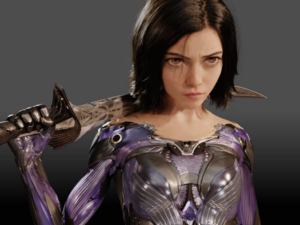
At Lightstorm, Berneham engaged his visual effects colleagues in a collaborative manner, a process aided by the fact that they all worked together in some fashion on Avatar. “We have dailies, just like any other VFX film, Berneham revealed. “We go and sit in the room and review together and assess the work and see where we can improve. Our goal is to put the best thing on screen.”
Down at Weta Digital, Saindon supervised 600 people on the Alita crew, at its peak. “We have our dailies, we put stuff together, then we have our review with Lightstorm everyday,” he said. “I’m doing the same thing Richard’s doing but down there [in New Zealand], people putting things together at Weta, and then we review it with Richie, looking at all the material we shot, finding the best way to put it together and the best way to improve shots everyday.”
From an animation perspective, Cozens worked with effects artists to evolve the behavior of the digital Alita character. “We’re assembling performance, assembling [digital] cameras into ideas to pitch for shot problems; we review it with these guys and Robert, coming back with direction, refining that process,” Cozens related. “We’ll put vignettes together. Richie will put [digital] cameras on them, send back the cameras, and we [add] the animation. It’s an iterative collaborative loop we’ve created in order to work through the shot construciton process, in order to create the best possible shot.”
Underscoring Cozens, Berneham described his cyclical process of pitching shot ideas, blocking them, then creating rough animation, and adding digital cameras to execute the shot, with the digital elements eventually merging with the live-action cinematography. “We produce a set of dailies, and then once we have a refined sequence, we take the animation to the ‘nth’ degree,” he said. “This gets back to all the same parameters you have for every other movie—although you have a very broad spectrum of design in this movie, from a photorealistic Alita to [differentiated] designs for other characters. But we still tried to make them all live in one world, and, obviously she’s the bridge. Then we carry through [digital animation] into the live-action plates with Christoph [Waltz who plays Dr. Dyson Ido]. You have this marriage that has to be relatively seamless.”
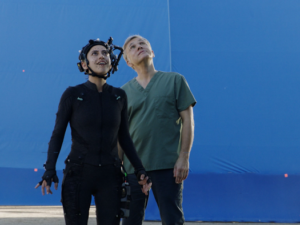
Finally, Saindon communicated that the experience with Rodriguez was positive, to the overall benefit of the film. “It’s about trying to make the shot better, which I’m all for,” Saindon said. “A director who is indecisive is pushing to get something better but can’t decide what they like. Robert is a true artist, always striving to make something better. On all of these movies, the best thing for me is working with really great directors. I don’t remember the movies—I tend to remember the personalities and the things that I’ve learned from them.”





